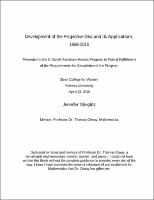Please use this identifier to cite or link to this item:
https://hdl.handle.net/20.500.12202/4097Full metadata record
| DC Field | Value | Language |
|---|---|---|
| dc.contributor.author | Stieglitz, Jennifer | - |
| dc.date.accessioned | 2018-11-06T18:47:29Z | - |
| dc.date.available | 2018-11-06T18:47:29Z | - |
| dc.date.issued | 2016-04 | - |
| dc.identifier.uri | https://hdl.handle.net/20.500.12202/4097 | - |
| dc.identifier.uri | https://ezproxy.yu.edu/login?url=https://repository.yu.edu/handle/20.500.12202/4097 | |
| dc.description | The file is restricted for YU community access only. | - |
| dc.description.abstract | In the late 19th century, the projective disc arose as a Euclidean model for nonEuclidean geometry. To understand this development, however, one must first examine the concept of Euclidean geometry itself. A fundamental principle of mathematics is the notion of creating and evaluating statements, and attempting to prove that they are in fact true, while rejecting them if they cannot be proven true or are proven to be false. Euclid, a mathematician in Alexandria in the fourth century BCE, included in his famous work, Elements, a discussion of mathematical statements that could be deemed “true” without actual proof, simply because their truth was obvious. | en_US |
| dc.description.sponsorship | S. Daniel Abraham Honors Program | en_US |
| dc.language.iso | en_US | en_US |
| dc.publisher | Stern College for Women | en_US |
| dc.rights | Attribution-NonCommercial-NoDerivs 3.0 United States | * |
| dc.rights.uri | http://creativecommons.org/licenses/by-nc-nd/3.0/us/ | * |
| dc.subject | Geometry, Hyperbolic. | en_US |
| dc.subject | Geometry, Non-Euclidean. | en_US |
| dc.subject | Hyperbolic spaces. | en_US |
| dc.subject | Space and time --Mathematical models. | en_US |
| dc.title | Development of the Projective Disc and its Applications, 1868-2015 | en_US |
| dc.type | Thesis | en_US |
| Appears in Collections: | S. Daniel Abraham Honors Student Theses | |
Files in This Item:
| File | Description | Size | Format | |
|---|---|---|---|---|
| Jennifer-Stieglitz.pdf Restricted Access | 402.24 kB | Adobe PDF |  View/Open |
This item is licensed under a Creative Commons License

